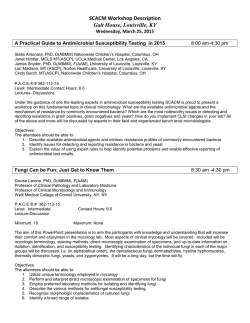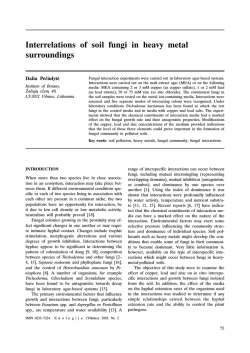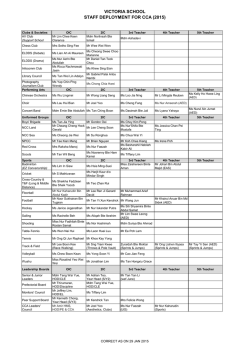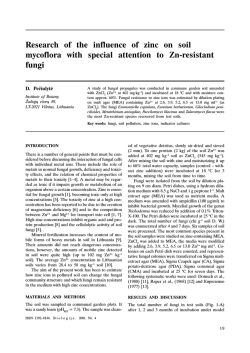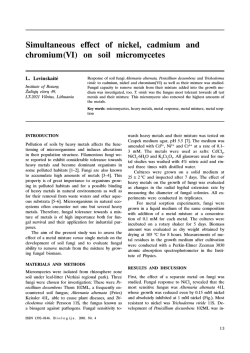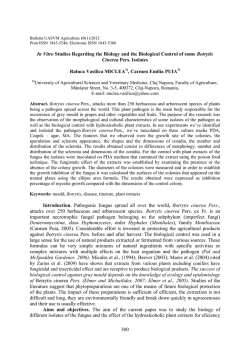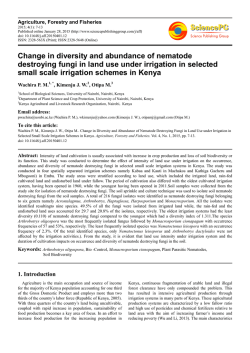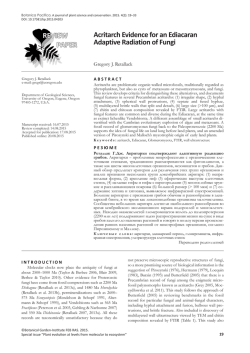
Isolation and characterization of endophytic fungi from medicinal
Available online www.jocpr.com Journal of Chemical and Pharmaceutical Research, 2015, 7(1):757-762 Research Article ISSN : 0975-7384 CODEN(USA) : JCPRC5 Isolation and characterization of endophytic fungi from medicinal plant, buah makassar(Makassar fruit: Brucea javanica) Nur Amin1, Fitrianti2 and Muh. Danial Rahim1 1 Department of Plant Protection, Faculty of Agriculture, Hasanuddin University, Makassar, South Sulawesi – Indonesia 2 Undergraduate Student of the Department Plant Protection, Faculty of Agriculture, Hasanuddin University, Makassar, South Sulawesi – Indonesia _____________________________________________________________________________________________ ABSTRACT Brucea javanica (L.) Merr. is a member of Simaroubaceae which call as Makassar Fruit and having medicinal potency. In the last few years fungal endophytes have been detected in hundreds of plants including medicinal plants. The current study aimed to isolate and characterization of endophytic fungi from roots, stems, leaves and fruit of Makassar fruit B. javanica. A total of 4 (four) genera of endophytic fungi were identified, which Trichoderma sp. isolated from roots and stems, Fusarium sp and Penicillium sp from fruits and Aspergillus sp from leaves. Key words: Endophytic Fungi, Brucea javanica, Makassar Fruit, Medicinal Plant _____________________________________________________________________________________________ INTRODUCTION The term endophyte was coined by the German scientist, Heinrich Anton De Bary in 1884, and used to define fungi and bacteria occurring inside plant tissues without causing any apparent symptoms in the host (Schulz et al, 2006). In the last few years fungal endophytes have been detected in hundreds of plants including important agricultural commodities as wheat [1], bananas [2], maize [3]; cocoa plant [4]. A number of authors have documented that the presence of endophytic fungi in medicinal plant, such as Aquilaria sinensis [5], Acorus calamus rhizomes [6], Juniperus communis L. Horstmann [7], Withania somnifera [8,9] , the Chinese medicinal plant, Tripterygium wilfordii [10] and Brucea sp. [11,12,13,14]. Brucea javanica (L.) Merr. is a member of Simaroubaceae which call as Makassar Fruit (Indonesia), lada hitam (Malaysia) as well as "Ya-Dan-Zi" and "Ya-Tan-Tzu" (China). The bitter fruits of medicinal plant Brucea javanica (L.) Merr. is widely used in traditional medicine for various ailments [15]. Bruceine A, a natural quassinoid compound extracted from the fruits of B. javanica (L.) Merr., with a wide spectrum of biological effects, such as having potential antibabesial [16], antitrypanosomal [11,15]; antimalarial [17,18,19] and cytotoxicity against human cancer cell lines [20,21]. Other biological activities such as anti-protozoan [22] and anti-inflammatory Hall et al. [23] activities have also been studied regarding its use among the traditional medicine practitioners. 757 Nur Amin et al J. Chem. Pharm. Res., 2015, 7(1):757-762 ______________________________________________________________________________ Figure 1. Makassar Fruit (Brucea javanica) EXPERIMENTAL SECTION Sample Collection Healthy plants with roots, leaves, stems and fruits of B.javanica taken and collected from various places of Takalar Region, Province of South Sulawesi, Indonesia. The samples were collected by aseptic procedures and brought to the laboratory of Plant Protection Department, Faculty of Agriculture, Hasanuddin University, Indonesia and processed within 24 hours of collection. Isolation of Endophytic Fungi Endophytic fungi were isolated according the protocols described by Petrini 1986, which were slightly modified based on preliminary tests. The roots, leaves, stems and fruits of B.javanica taken from the field were washed twice in distilled water then surface sterilized by immersion for 1 minute in 70% (v/v) ethanol, 5 minutes in sodium hypochlorite (2.5 % (v/v) available chlorine) and 30 seconds in 70% (v/v) ethanol and then washed three times in sterilized distilled water for 1 minute each time. After surface sterilization, the samples were cut into 5 mm pieces and aseptically transferred to plates containing potato dextrose agar (PDA, pH 6.8, containing (g/l): potato 200; dextrose 20; agar 15.), which had been autoclaved for 15 minutes at 121ºC and then aseptically supplemented with 100 mg/ml of chloramphenicol (Pfizer) to suppress bacterial growth. Aliquots from the third wash were plated onto PDA to check that surface sterilization had been effective and they were then incubated at 28ºC. Any fungi present was isolated, purified and then maintained at 4ºC on PDA slopes for further identification. For tentative identification, microscopic slides of each fungal endophyte were prepared, examined under light microscope (Olympus, USA) and identified with reference to [24,25]. RESULTS AND DISCUSSION Endophytic fungi isolated from roots, leaves, stems and fruits of B.javanica were identified 4 genera such as Trichoderma sp., (roots and stems), Fusarium sp. (fruits and stems), Aspergillus sp. (leaves) and Penicilium sp. (Fruits) (Table 1). Trichoderma sp. characterized by green colored colonies and there is also a white spot (Figure 2a,b,c). Trichoderma sp. have half-round to oval conidia, upright branched conidiophores and conidia at the end is fialit. Fusarium sp. characterized by very rapid growth of hyphae and orange, dark red clamidospora, which stick to the walls of petridishes if the age of 3 days. Microscopic identification results showed that the crescent-shaped makrokonidia with 3-5 septa and clamidospora is round and slightly oval (Figure 3a, 3b). 758 Nur Amin et al J. Chem. Pharm. Res., 2015, 7(1):757-762 ______________________________________________________________________________ Table 1. Diversity of endophytic fungi from roots, leaves, stems and fruits of B.javanica No Genera Macroscopic characterization on PDA media 1. Trichoderma sp Green colored colonies and there is also a white spot 2. Fusarium sp. The colony of cotton white and fine texture 3. Penicillium sp. Coloni white 4. Aspregillus sp Blackish brown Microscopic characterization - Conidia half-round to oval - Upright branched conidiophores - Conidia at the end fialit - Macro and microconidia are presence - Hyphae have septae - Microconidia is crescent and have septae - Finger-shaped conidiophores - There are 2-3 hyphae per branch - Conidia round, slightly oval - Smooth conidiophores where hyphae perpendicular - Conidia round - At the end of hyphae forming Globusa Sources Roots and Stems Fruits and Stems Fruits Leaves B A C Figure 2: Endophytic Fungi Trichoderma sp, (a) Colony performance on the PDA (b) conidia and (c) Conidiophores Fusarium sp B A D C Figure 3: Endophytic Fungi Fusarium sp, (a) Colony performance on the PDA (b) macroconidia , (c) hyphae, (d) conidia 759 Nur Amin et al J. Chem. Pharm. Res., 2015, 7(1):757-762 ______________________________________________________________________________ The colony performance on the PDA media by Penicillium sp. is white colony, irregular mycelium, colony growth flat, thick, flat edge of the colony . Microscopic characteristic is Finger-shaped conidiophores, there are 2-3 hyphae per branch. On the whole surface is covered vesicles fialid formed and the formed conidia fialid in sequence . Conidia are round , hyaline , and arrayed 1 cells. B A C D Figure 4: Endophytic Fungi Penicillium sp, (a) Colony performance on the PDA (b) conidia , (c) hyphae, (d) conidiophore A B C D Figure 4: Endophytic Fungi Aspergillus sp, (a) Colony performance on the PDA (b) conidia , (c) hyphae, (d) conidiophore The fungus Aspergillus sp. on morphological appearance is blackish brown on PDA media. Feature of microscopy : spherical conidia, upright hyphae, conidiophores smooth, long and formed freely. Aspergillus sp conidia carrier has a large head and a dense, round and black. Microscopic observations above adapted to the description [24], which 760 Nur Amin et al J. Chem. Pharm. Res., 2015, 7(1):757-762 ______________________________________________________________________________ states that the vesicle surface is covered fialid that produce conidia. Conidia arranged 1 cells and has a variety of colors. Conidial heads are black and round. DISCUSSION The results of the isolation and identification of endophytic fungi from Makassar fruit isolated 4 genera, which Trichoderma sp. isolated from roots and stems, Fusarium sp and Penicillium sp from fruits and Aspergillus sp from leaves. According to Liang et al [26], a total of 83 endophytic fungi strains were isolated from the root, stem, leaf and fruit of Brucea javanica. 34 strains were obtained from the stem,32 strains were obtained from the leaf, 15 strains were isolated from the root and 2 strains came from the fruit. These 73 strains which had been identified attribute to 5 orders, 6 families and 12 genera. The other medicinal plant Tripterygium wilfordii isolated endophytic fungi such as Colletotrichum gloeosporioides, Guignardia sp., Glomerella cingulata, Pestalotiopsis spp., Phomopsis spp. and Phyllosticta sp. [10]. In the current study have been isolated Trichoderma sp. from roots and stems of Makassar Fruit B. javanica. This fungus produced a wide range of phenolic substances such as glycosides as strong antioxidant and anti-mutagenic activities thus, can be used against cancers [27]. Glycosides are usually compounds which have been isolated in plants, made up of one or more sugars combined with an alcohol, a phenol, or a complex molecule such as a steroid nucleus. Many plants contain cardiac glycosides, which occur both in monocotyledons and in dicotyledons and have been documented as one of the chemicals in 20 well documented poisonous plants and equally possesses antimicrobial properties [28]. The ability of an endophyte to produce some metabolites but not others has been described by Selim et al. [29]; where different endophytes in a plant may produce different secondary metabolites hence play different functions in the plant and that the total number of metabolites in a plant extract maybe a contribution of all the endophytes that live in the plant. The available secondary metabolites have anti-pathogenic properties and their roles in plant defense have been elaborated in the works of Hari et al and Figen [27, 28], and could be responsible for the function of the plant extracts in defense against plant and animal pathogens. Liang et al [26] and Kumar, D.S.S and Hyde, K.D [10] get the different result with the current study in term of the amount and tipe of endophytic fungi. According to Nur Amin et al [4] the different result influenced by biotic and abiotic factors. Biotic factors consist of varieties and species of host. While abiotic factors that influence the weather factors that temperature , relative humidity and moisture content of the soil and cultivation techniques. CONCLUSION A total of 4 (four) genera of endophytic fungi were identified, which Trichoderma sp. isolated from roots and stems, Fusarium sp and Penicillium sp from fruits and Aspergillus sp from leaves. REFERENCES [1] Larran, S., Perello, A., Simon, M.R., Moreno, V. World Journal of Microbiology & Biotechnology., 2002, 18, 683–86. [2] Nur Amin. Untersuchungen uber die Bedeutung endophytischer Pilze fur die biologische Bekampfung des wandernden Endoparasiten Radopholus similis (Cobb) Thirne an Bananen. 1994, PhD-Thesis, 112 p. Bonn University. [3] Nur Amin. International Journal of Current Microbiology and Applied Science. 2013, 2 (8) : 148-54. [4] Nur Amin., Salam, M., Junaid, M., Asman and Baco, MS. International Journal of Current Microbiology and Applied Science. 2014, 3 (2) : 459 – 67 [5] Jin, L.C and Pei, G.X. J Zhejiang Univ Sci B. 2011, 12 (5): 385–92. [6] Barik, B.P., Tayung, K., Jagadev, P.N., Dutta, S.K. 2010. Eur. J. Biol. Sci. 2010, 2 (1) : 8-16 . [7] Kusari, S., Lamshoeft,M and Spiteller, M. J. Appl. Microbiol. 2009, 107(3): 1019-30. [8] Khan, R; Saleem, S, Chodhary, MI; Khan SA and Ahmad, A. Vet Parasitol. 2008, 20 : 158 (4) : 288-94 [9] Kumar, S; Nutan, K and Peter, P. Springer Plus. 2013, 2 : 37. [10] Kumar, D.S.S. and Hyde, K.D. Fungal Diversity. 2004, 17: 69-90. [11] Subeki, Matsuura, H., Takahashi, K., Nabeta, K., Yamasaki, M., Maede, Y and Katakura, K. J Nat Prod. 2007, 70 (10) :1654-57 [12] Lu, J.B, Shu, S.Y and Cai, J.Q. Zhongguo Zhong Xi Yi Jie He Za Zhi. 1994, 14 ( 10 ), 610-11 761 Nur Amin et al J. Chem. Pharm. Res., 2015, 7(1):757-762 ______________________________________________________________________________ [13] Lau, F.Y., Chui, C.H., Gambari, R., Kok, S.H., Kan, K.L., Cheng, G.Y., Wong, R.S, Teo, Cheng, C.H, Wan, T.S., Chan, A.S and Tang, J.C. Int J Mol Med. 2005, 16 ( 6 ) : 1157-62 . [14] Kim, I.H., Takashima, S., Hitotsuyanagi, Y., Hasuda, T and Takeya, K. J Nat Prod . 2004, 67 ( 5 ): 863-8. [15] Bawm, S., Matsuura, H., Elkhateeb, A., Nabeta, K., Subeki, Nonaka, N., Oku, Y., Katakura, Vet Parasitol. 2008, 20 : 158(4):288-94 [16] Yamada, K., Subeki., Nabeta, K., Yamasaki, M., Katakura, K and Matsuura, H. Biosci. Biotechnol.Biochem. 2009, 73 [17] Pavanand, K., Nutakul, W., Dechatiwongse, T., Yoshihira, K., Yongvanitchit, K., Scovill, J. P., FlippenAnderson, J. L., Gilardi, R. & George, C. 1986, Planta Med. 52, 108-111. [18] O’Neill, M. J., Bray, D. H., Boardman, P., Chan, K. L., Phillipson, J. D., Warhurst, D. C. and Peters, W. 1987, J. Nat. Prod. 50, 41-48. [19] Kim H-S., Shibata Y., Ko N., Ikemoto N., Ishizuka Y., Murakami N., Sugimoto M., Kobayashi M., Wataya Y. Parasitology International. 2000, 48 :271-274. [20] Zhao, L., Li, C., Zhang, Y., Wen, Q and Ren, D. Anticancer Agents Med Chem. 2014, 14 (3) : 440-58. [21] Hong, Z., Jing, Y.Y., Fan, Z., Li H.W., Wen, Z., Sha, S and Chun, F.W. Evidence-Based Complementary and Alternative Medicine. 2011, 1-14 [22] Sawangjaroen, N and Kitja, S. Journal of Ethnopharmacology. (2005), 98 :67–72 [23] Hall, I.H., Lee, K.H., Imakura, Y., Okano,M and Johnson, A. J. Pharm. Sci. 1983, 72, 1282–1284. [24] Barnet, H.L and Hunter, B.B, Illustrated genera of imperfect fungi. 1998, 4th ed. APS Press. St. Paul. Minnesota. p. 218 [25] Dugan, F.M, The Identification of Fungi: An Illustrated Introduction With key, Glossary and Guide to Literature. 2006, The American Phytopathological Society, St. Paul. Minnesota. p. 184. [26] Liang., Z.N, Zhu, H, Lai, K.P and Chen, L. Zhong Yao Cai. 2014, 37(4):564-8. [27] Hari, O., Anjana, S., Naseer, M and Santosh K. Journal of Chemical and Pharmaceutical Research. 2014, 6 (5) :756-760. [28] Figen, M.T.Ÿ. Journal of Cell and Molecular Biology. 2006, (13) 5:13-17. [29] Selim, K., El-Beih, A., Abdel-Rahman, T and El-Diwany, A. Current Research in Environmental & Applied Mycology. 2012, 2(1) : 31-82. 762
© Copyright 2026
